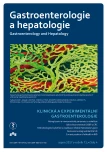Self-expandable coated metal Danis stent as a bridge to liver transplantation
Authors:
E. Kostolná; S. Fraňková; J. Šperl; P. Drastich; T. Hucl; J. Špičák
Authors‘ workplace:
Klinika hepatogastroenterologie, Transplantcentrum, IKEM, Praha
Published in:
Gastroent Hepatol 2017; 71(4): 299-303
Category:
Clinical and Experimental Gastroenterology: Case Report
doi:
https://doi.org/10.14735/amgh2017299
Overview
We report a case of a 66-year-old female without substantial internal comorbidities. In September, 2010, she was treated for 3 weeks with amoxicillin at a dose of 1,000 mg daily for suspected Lyme disease (erythema migrans). Before the end of antibiotic treatment, the patient presented with jaundice and was diagnosed with advanced liver cirrhosis, which was very likely autoimmune in origin. The acute deterioration was ascribed to “acute-on-chronic” liver failure caused by drug toxicity. Owing to the progression of liver dysfunction, the patient was indicated for liver transplantation. The third day after enlistment, she presented with acute variceal bleeding. Treatment with endoscopic ligation failed and, thus, a self-expandable coated metal esophageal stent Danis was inserted. Because of the significant hepatic insufficiency and prolonged encephalopathy, it was not possible to perform TIPS and the Danis stent was maintained up until liver transplantation. The third day after ortotopic liver transplantation, and a total of 12 days after the introduction of the stent, the esophageal stent was extracted without complications and with only minimal superficial ulcerations visible on the mucosa. Seven years after the intervention, the patient still shows good liver graft function.
Key words:
variceal bleeding – self-expandable stent – liver transplantation
The authors declare they have no potential conflicts of interest concerning drugs, products, or services used in the study.
The Editorial Board declares that the manuscript met the ICMJE „uniform requirements“ for biomedical papers.
Submitted:
3.5. 2017
Accepted:
24. 7. 2017
Sources
1. Haq I, Tripathi D. Recent advances in the management of variceal bleeding. Gastroenterol Rep (Oxf) 2017; 5 (2): 113–126. doi: 10.1093/gastro/gox007.
2. de Franchis R. Baveno VI Faculty. Expanding consensus in portal hypertension: report of the Baveno VI Consensus Worshop: stratifying risk and individualizing care for portal hypertension. J Hepatol 2015; 63 (3): 743–752. doi: 10.1016/j.jhep.2015.05.022.
3. Krajina A, Hulek P, Fejfar T et al. Quality improvement guidelines for Transjugular Intrahepatic Portosystemic Shunt (TIPS). Cardiovasc Intervent Radiol 2012; 35 (6): 1295–1300. doi: 10.1007/ s00270-012-0493-y.
4. Boyer TD, Haskal ZJ, American Association for the Study of Liver Diseases. The Role of Transjugular Intrahepatic Portosystemic Shunt (TIPS) in the Management of Portal Hypertension: update 2009. Hepatology 2010; 51 (1): 306. doi: 10.1002/hep.23383.
5. Escorsell À, Pavel O, Cárdenas A et al. Esophageal balloon tamponade versus esophageal stent in controlling acute refractory variceal bleeding: a multicentre randomized, controlled trial. Hepatology 2016; 63 (6): 1957–1967. doi: 10.1002/hep.28360.
6. Bañares R, Albillos A, Rincón D et al. Endoscopic treatment versus endoscopic plus pharmacologic treatment for acute variceal bleeding: a meta-analysis. Hepatology 2002; 35 (3): 609–615.
7. Fejfar T, Safka V, Jirkovsky V et al. Danišův jícnový stent v terapii varikózního krvácení. Gastroent Hepatol 2013; 67 (2): 98–103.
8. Fejfar T, Vaňásek T, Brůha R et al. Léčba krvácení v důsledku portální hypertenze při jaterní cirhóze – aktualizace doporučených postupů ČHS ČLS JEP. Gastroent Hepatol 2017; 71 (2): 105–116. doi: 10.14735/amgh2017105.
9. Marot A, Trépo E, Doerig C et al. Systematic review with meta-analysis: self-expanding metal stents in patients with cirrhosis and severe or refractory oesophageal variceal bleeding. Aliment Pharmacol Ther 2015; 42 (11–12): 1250–1260. doi: 10.1111/apt.13424.
10. Drastich P, Brezina J, Sperl J et al. Treatment of uncontrollable acute variceal bleeding with self-expanding metal stent: a single center experience. Gastroenterology 2016; 150 (4 Suppl 1): S339. Abstract Sa1600. doi: 10.1016/S0016-508 5 (16) 31190-8.
11. Dechêne A, El Fouly AH, Bechmann LP et al. Acute management of refractory variceal bleeding in liver cirrhosis by self-expanding metal stents. Digestion 2012; 85 (3): 185–191. doi: 10.1159/000335 081.
12. Holster IL, Kuipers EJ, van Buuren HR et al. Self-expandable metal stents as definitive treatment for esophageal variceal bleeding. Endoscopy 2013; 45 (6): 485–488. doi: 10.1055/s-0032-1326227.
13. Hubmann R, Bodlaj G, Czompo M et al. The use of self-expanding metal stents to treat acute esophageal variceal bleeding. Endoscopy 2006; 38 (9): 896–901.
14. Müller M, Seufferlein T, Perkhofer L et al. Self-expandable metal stents for persisting esophageal variceal bleeding after band ligation or injection-therapy: a retrospective study. PLoS One 2015; 10 (6): e0126525. doi: 10.1371/journal.pone.0126525.
Labels
Paediatric gastroenterology Gastroenterology and hepatology SurgeryArticle was published in
Gastroenterology and Hepatology

2017 Issue 4
Most read in this issue
- Outcome of treatment of Helicobacter pylori infection based on microbiological susceptibility testing following the unsuccessful second-line eradication treatment
- Self-expandable coated metal Danis stent as a bridge to liver transplantation
- Acute appendicitis – a rare complication of colonoscopy
- Graft-duodenal fistula – a cause of massive gastrointestinal bleeding
